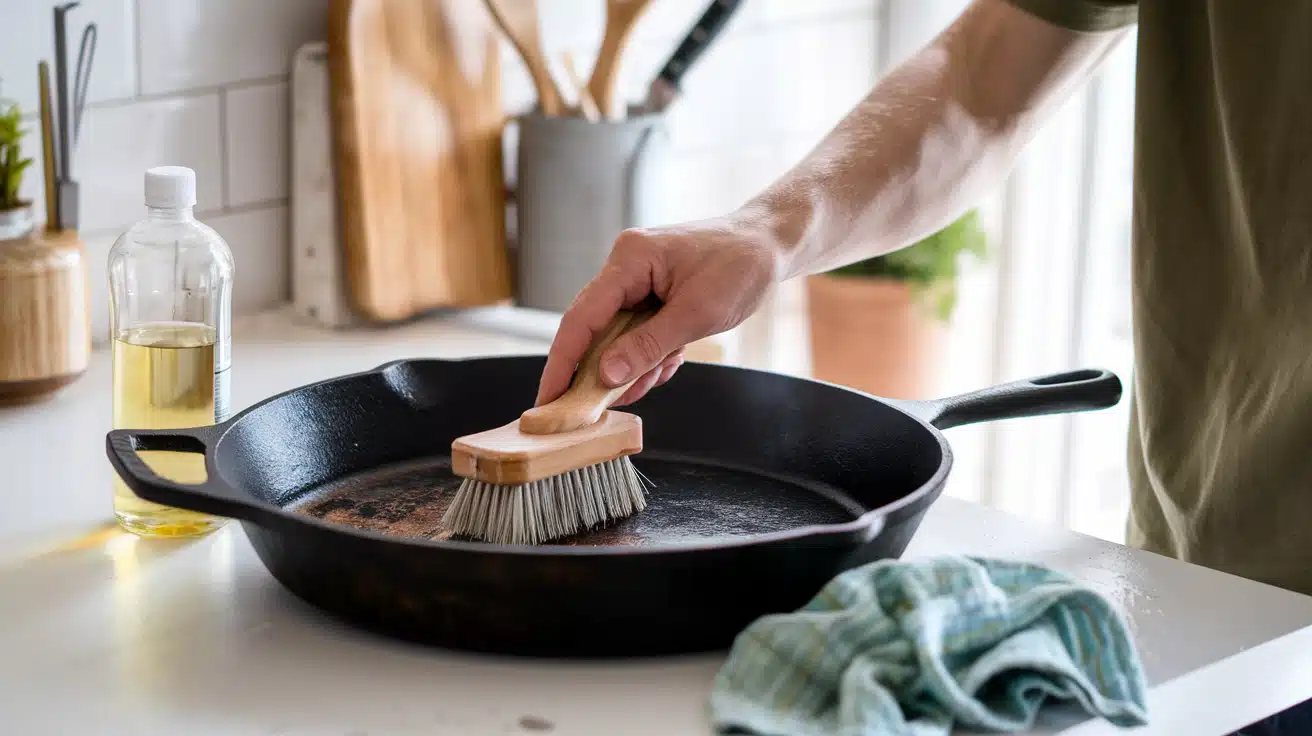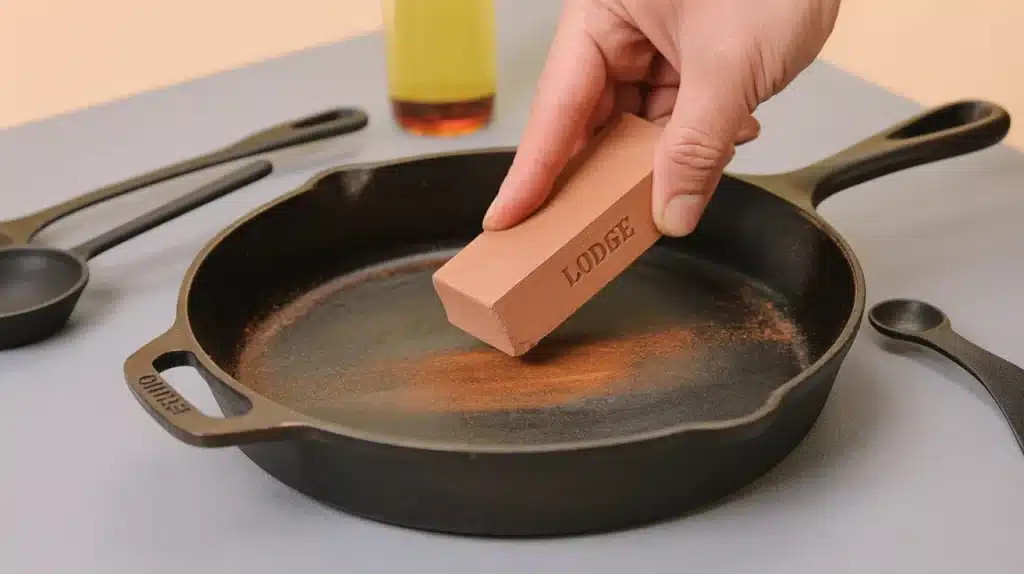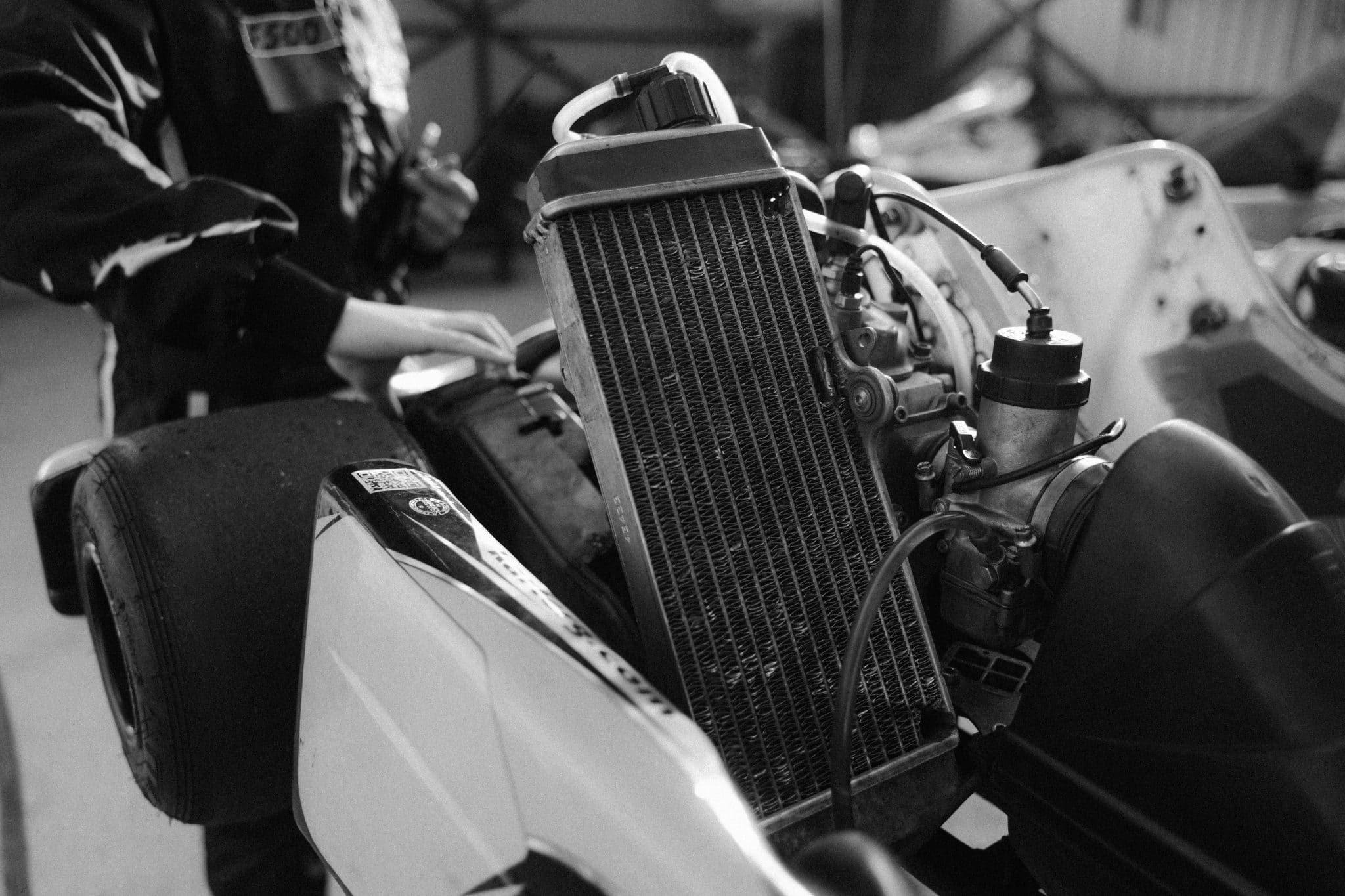I know the frustration of pulling out your favorite cast iron pan only to find rust spots covering the surface. I’ve watched perfectly good cookware sit unused because rust made it look beyond repair.
The reality is that you can completely restore rusty cast iron using items you already have at home. I’m going to walk you through a proven process that brings even heavily rusted pans back to life.
This guide covers six straightforward steps that will restore your rusty cookware to its original cooking condition.
You’ll learn the baking soda method, proper drying techniques, seasoning application, and maintenance tips that prevent future rust problems. I’ll also share alternative removal methods for stubborn cases.
By the end, you’ll have the confidence to rescue any rusty cast iron and keep it in perfect condition for years of cooking.
Why Rust Happens & Why It’s Fixable
Cast iron cookware develops rust when exposed to moisture and oxygen over time.
This natural process occurs faster when pans are stored wet, washed with harsh soaps, or left without protective seasoning.
The good news is that rust only affects the surface layer of the iron.
Why Rust Forms:
- Moisture exposure – Water left on surfaces
- Missing seasoning – No oil protection layer
- Poor storage – Humid environments
- Improper cleaning – Harsh detergent strips protection
Why It’s Always Fixable:
- Rust stays on the surface only.
- Household items can remove rust buildup.
- New seasoning restores full protection.
- Even heavy rust can be completely removed.
The key is acting quickly when rust appears. Small spots can be fixed in minutes, while heavy rust may require a few extra steps. Either way, cast iron’s durability means it can withstand almost any condition.
Step-by-Step Guide to Restoring Your Cast Iron Cookware
Cast iron cookware can last for generations with proper care and restoration. Follow these simple steps to remove rust and bring your pans back to their original condition.
Tools and Materials Required:
| Tools & Materials | Purpose |
|---|---|
| Cast Iron Cookware | The item to restore |
| Baking Soda | Creates a paste to remove rust |
| Water | Mixes with baking soda for the paste |
| Salt | Scrubs off food debris |
| White Vinegar | Neutralizes baking soda |
| High-Smoke Point Oil | For seasoning after cleaning |
| Oven | Dries and seasons cookware |
| Scrub Brush/Chainmail Scrubber | Scrub off rust and paste |
| Towel | Dries cookware |
Step 1: Creating Your Rust-Fighting Paste
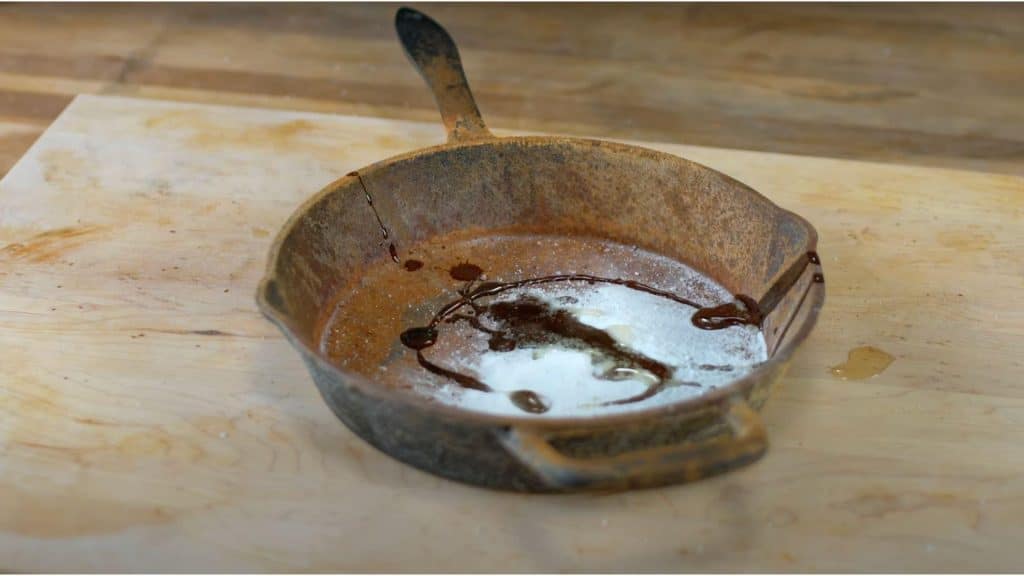
Baking soda acts as a gentle abrasive that breaks down rust without damaging the iron surface.
This natural cleaning agent works by creating an alkaline environment that loosens rust particles.
The paste consistency ensures the baking soda stays in contact with rusty areas long enough to work effectively.
- Mix baking soda with water to form a thick paste
- Apply the paste generously over rusty areas
- Let sit for 15-20 minutes
Pro Tip: Make the paste slightly thicker than toothpaste for better coverage. A thicker mixture stays in place longer and works more effectively on vertical surfaces.
Step 2: Removing Rust Through Scrubbing
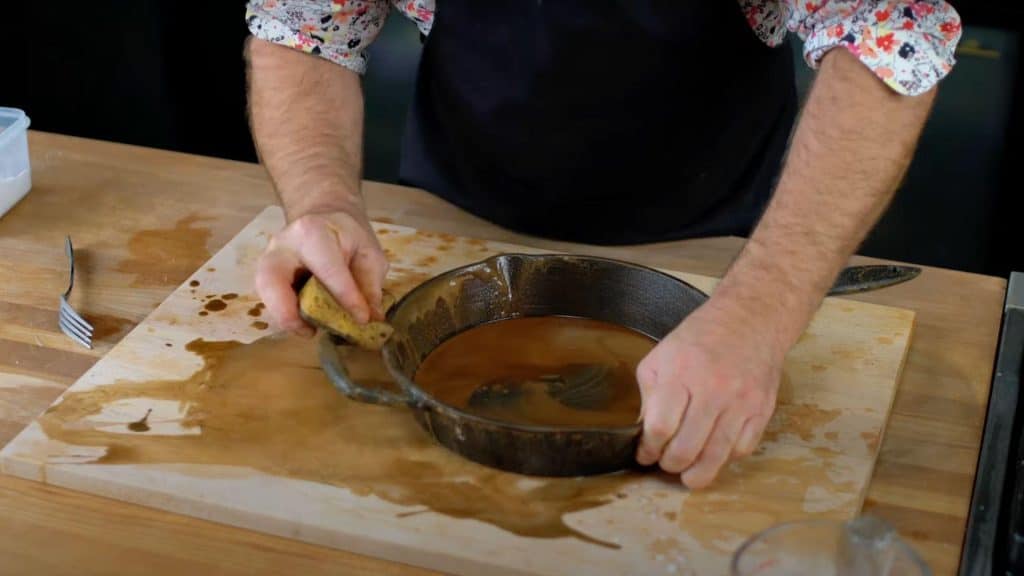
Mechanical action combined with the baking soda paste removes even stubborn rust buildup.
The scrubbing process breaks the bond between rust and iron, while the paste lifts away loose particles.
Different tools work better for different areas of the cookware.
- Scrub with steel wool or a chainmail scrubber
- Work in circular motions on all surfaces
- Focus on corners and crevices
- Repeat if rust remains
Pro Tip: Start with gentle pressure and increase gradually to avoid scratching the iron. Use fine steel wool for light rust and coarse for heavy buildup.
Step 3: Cleaning and Complete Drying
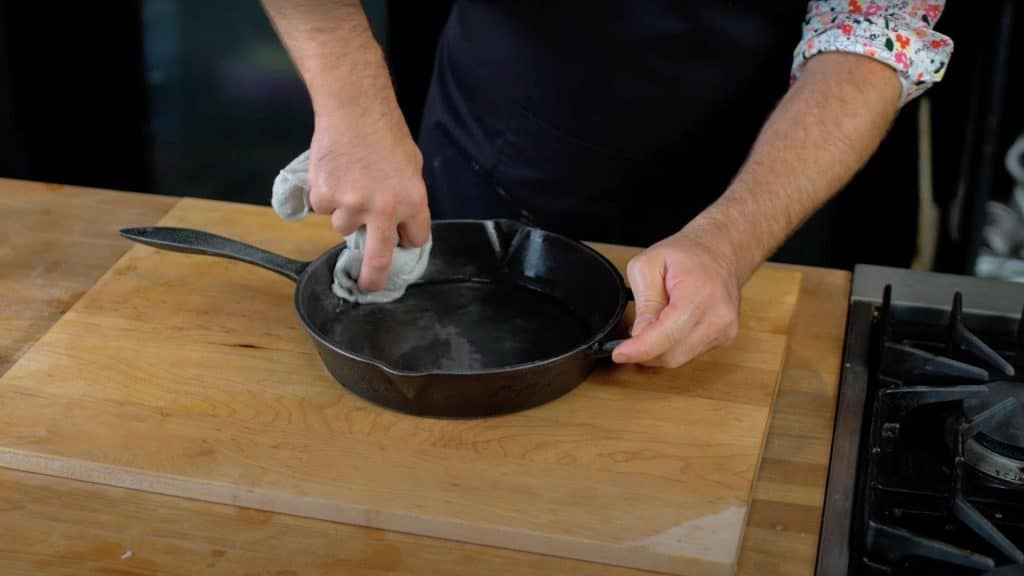
Water removal prevents new rust from forming immediately after cleaning.
Any moisture left on the surface will cause rust to return within hours.
Heat drying ensures complete moisture elimination from tiny pores in the iron.
- Rinse with warm water thoroughly.
- Dry immediately with clean towels
- Place in a 350°F oven for 10 minutes
Pro Tip: Check for water spots in handles and pour spouts where moisture hides. These areas rust fastest if not completely dried.
Step 4: Neutralizing Remaining Alkaline Residue
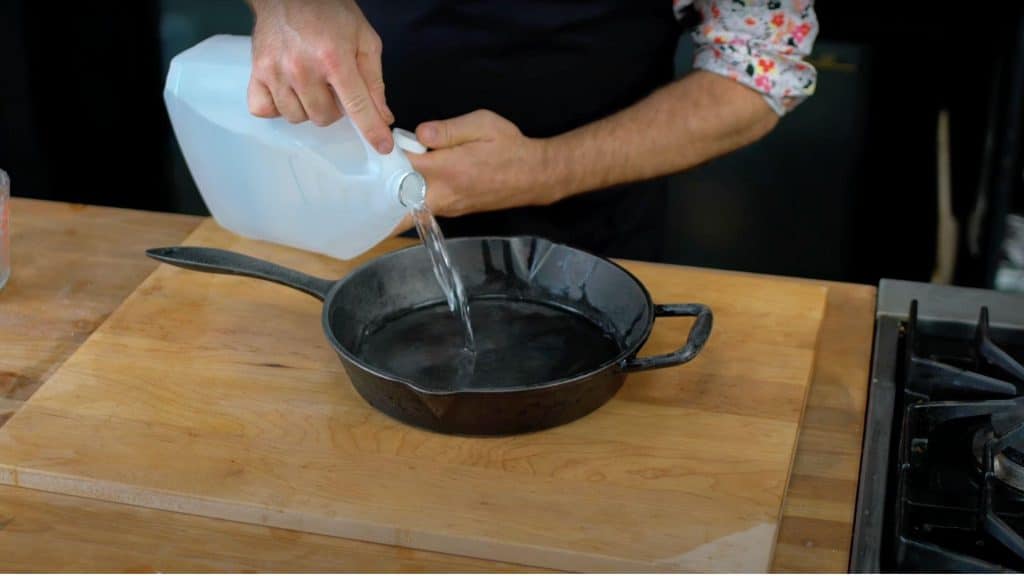
Baking soda residue can interfere with the seasoning process if not properly neutralized.
White vinegar’s acidity balances any leftover alkaline material.
This step prepares the surface for optimal oil absorption during seasoning.
- Pour white vinegar over the surface.
- Let it sit for 3-5 minutes.
Pro Tip: Use just enough vinegar to cover the bottom of the pan. Too much vinegar can cause pitting if left too long on the iron surface.
Step 5: Building Protective Seasoning Layers
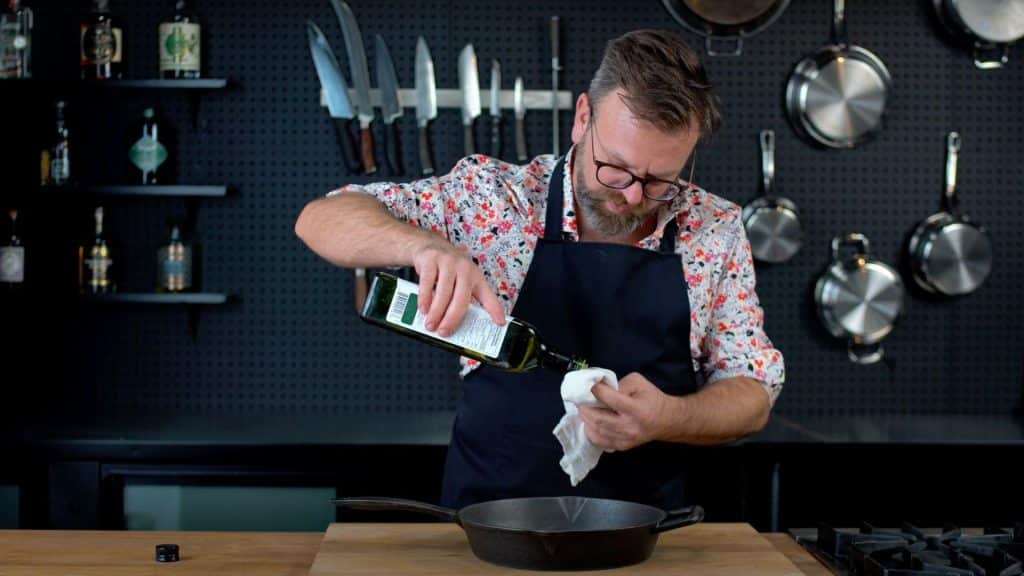
Seasoning creates a protective barrier that prevents future rust and provides a natural non-stick surface.
Multiple thin layers work better than one thick application. High-heat baking polymerizes the oil into a durable coating.
- Apply a thin layer of high-smoke-point oil
- Wipe excess oil until the surface appears dry
- Bake at 350°F for 1 hour upside down
- Repeat 3-5 times for stronger protection
Pro Tip: The cookware should look almost dry after wiping excess oil. Too much oil creates sticky spots instead of smooth seasoning.
Step 6: Maintaining Your Restored Cookware
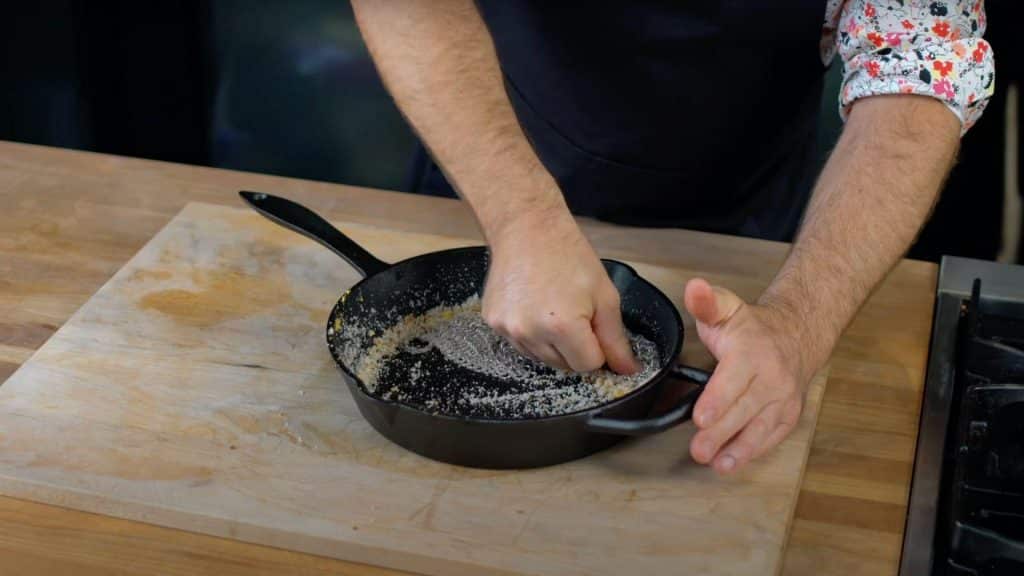
Proper maintenance prevents rust from returning and keeps the seasoning intact.
Avoiding soap preserves the oil coating while salt provides effective cleaning action.
Regular light oiling after each use maintains the protective barrier.
- Clean with coarse salt and a chainmail scrubber
- Avoid soap to preserve the seasoning
- Apply a light oil coating after cleaning
- Store in a dry location
Pro Tip: Heat the pan slightly before applying oil after cleaning. Warm iron absorbs oil better and creates a more even protective coating.
Video Tutorial
I’d like to give credit to Cook Avec Dan for their informative video, which served as a reference for this guide.
Alternative Methods For Rust Removal
When baking soda is unavailable or rust proves stubborn, several other household items and specialized tools can help restore cast iron cookware.
1. Potato and Salt Method
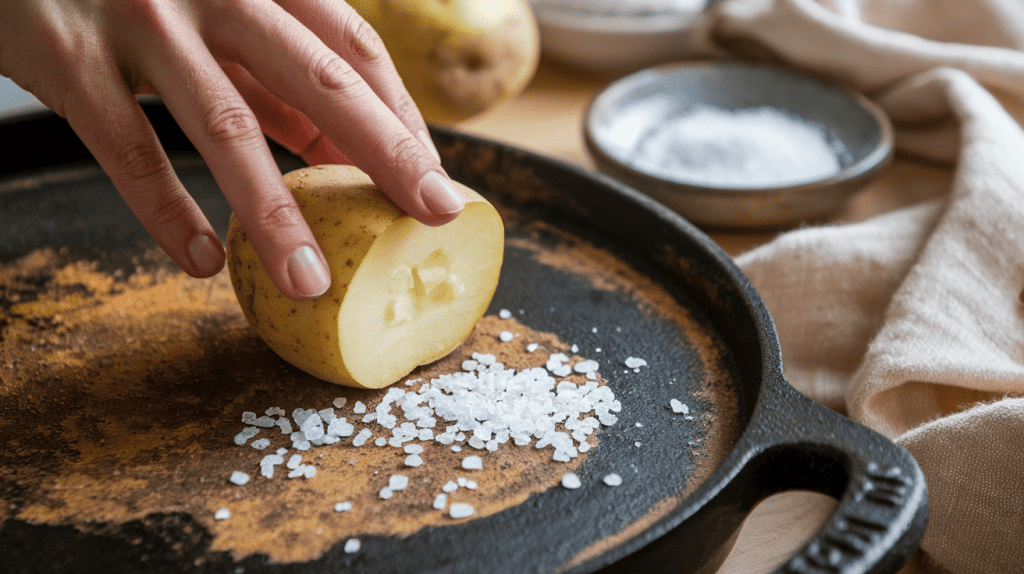
The potato and salt method uses natural acids found in potatoes combined with coarse salt’s scrubbing power.
Cut a potato in half, dip it in salt, and scrub rusty areas.
The oxalic acid in potatoes helps break down rust naturally, making this method perfect for light to moderate rust spots.
2. Coca-Cola Method
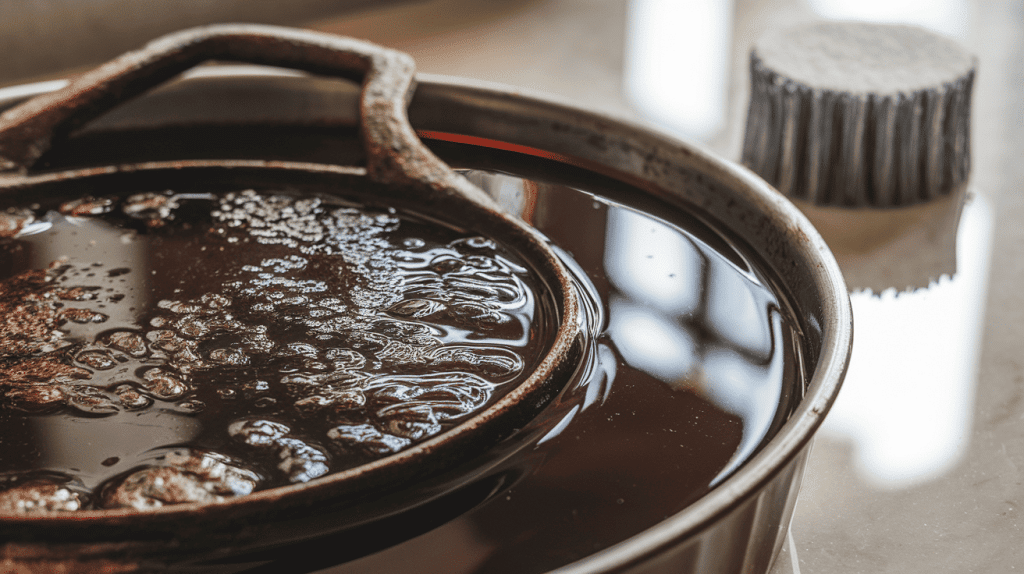
Coca-Cola contains phosphoric acid that dissolves surface rust effectively.
Soak the rusty cookware in cola for several hours, then scrub with steel wool and rinse thoroughly.
This method works well for rust that covers larger surface areas.
3. Lodge Rust Eraser Tool
Lodge makes a rust eraser tool designed specifically for cast iron restoration.
This specialized scrubber removes rust without damaging the underlying metal surface, making it perfect for spot treatment and regular maintenance work.
4. Steel Wool Rust Removal Method
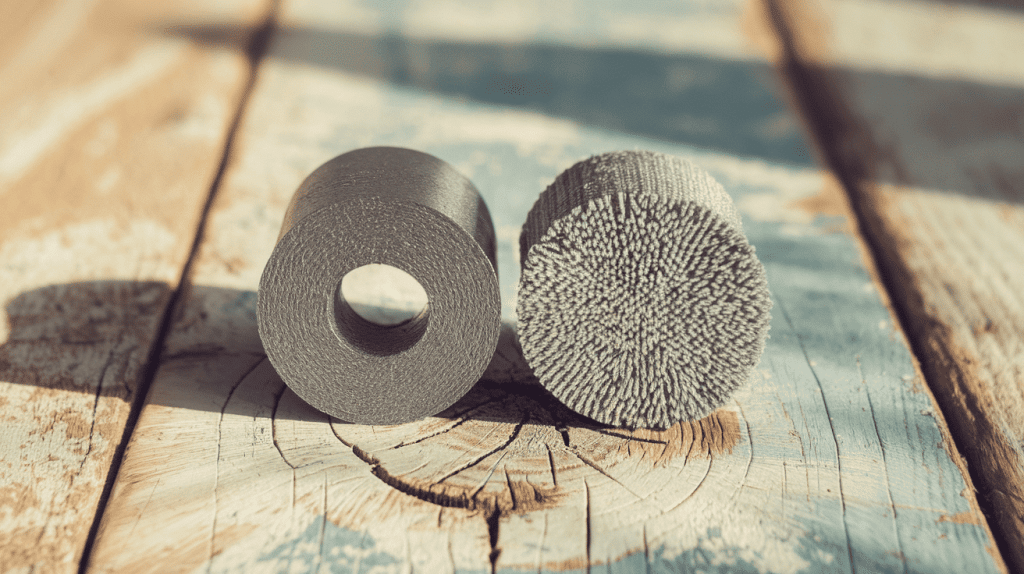
Steel wool comes in different grades to handle various rust levels. Fine steel wool works best for light surface rust, while coarse steel wool tackles heavy buildup.
Always scrub in circular motions to avoid creating scratch patterns on the iron surface.
How to Keep Your Cast Iron Rust-Free
Once you’ve restored your cast iron, maintaining it properly is key to preventing future rust. With just a few simple habits, you can keep your cookware in top condition for years to come.
-
Dry Thoroughly After Each Use: Always ensure your cast iron is completely dry before storing it. Moisture is a primary cause of rust, so avoid leaving water on the surface. For extra precaution, heat the pan on the stove or in the oven to evaporate any lingering moisture.
-
Apply a Thin Layer of Oil: After cleaning, wipe your pan with a thin layer of high-smoke-point oil. This will protect the surface and keep rust at bay. Make it part of your regular routine, especially after each wash.
-
Use Coarse Salt for Cleaning: Skip the harsh soaps, which strip away the protective seasoning. Instead, clean with coarse salt and a chainmail scrubber, which effectively removes food particles without damaging the seasoning.
-
Store in a Dry Location: Store your cast iron in a dry, well-ventilated area. If stacking multiple pieces, place paper towels between them to absorb moisture and prevent rust formation.
-
Re-season Regularly: If your seasoning starts to thin or food begins to stick, it’s time to re-season. Apply a new layer of oil and bake it in your oven for optimal protection.
Conclusion
Restoring rusty cast iron cookware isn’t just about saving money – it’s about preserving pieces that can serve your family for generations.
With these simple steps using household items like baking soda, vinegar, and oil, you’ve learned how to bring any rusted pan back to life.
The process may seem long initially, but remember that proper maintenance prevents future rust problems.
Regular drying, light oiling, and salt cleaning will keep your restored cookware in perfect condition for decades of cooking.
Cast iron’s durability means no piece is truly beyond repair. Even heavily rusted pans can return to their original glory with patience and the right technique.
Start with that rusty skillet sitting in your cabinet – you’ll be surprised how quickly it changes into a reliable cooking companion again.

